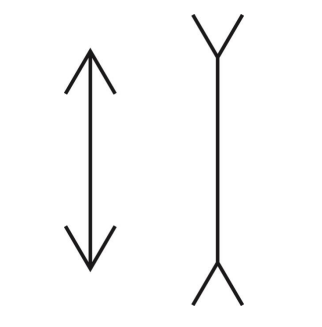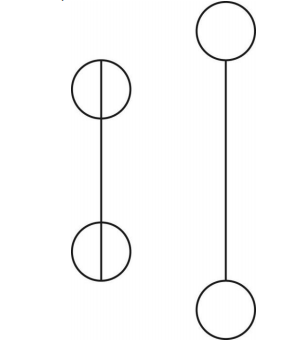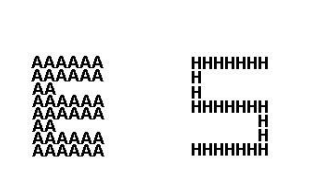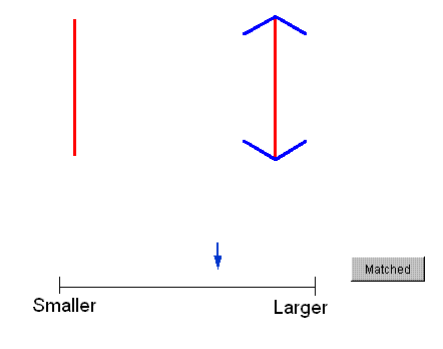Introduction
The Müller-Lyer illusion is a convenient illusion in which the evidence or perceived length of a line varies based on whether it ends in an arrow tailor is arrowhead (Sakiyama & Gunji, 2013). Based on the Müller-Lyer illusion, the right vertical lines are apparently longer than the left vertical line, although these lines are of exactly similar length (see figure 1 below). The illusion results from the presence of the fins, which make the lines to appear different in length. When the fins are in, the line appears shorter while when they are out, it appears longer. According to Müller-Lyer, this was ‘confluxion’. Researchers have focused on further studies to understand this illusion, but without a consensus on specific perceived principles responsible for the illusion (Dewar, 1967b) while other explanations have been rejected (Cooper & Runyon, 1970).
Psychologist, Richard Gregory had argued that the illusion resulted from a misapplication of size constancy scaling (Gregory, 1966). Generally, one can perceive an object in a more stable manner by considering the distance through size constancy. In this regard, an object should maintain its size irrespective of the distance, particularly with three-dimensional objects. Conversely, Delucia and Hochberg (1991) had difficulties providing explanations for the three-dimensional manifestation of illusion in their study. Gregory, however, had noted that errors could result when the same principle was applied to two-dimensional objects (Gregory, 1966).
Conversely, other studies have demonstrated that Gregory’s approach does not provide any sufficient account for the illusion. For instance, it is noted that when two circles are introduced at the end the lines to replace fins, the illusion is still noted, yet there are no depth cues (see figure 2).
Other studies have focused on gender differences to evaluate the Müller-Lyer illusion. For instance, a study by Baroun and Al-Ansari (2004) demonstrated that “gender had no significant correlation to the Müller-Lyer perception and Horizontal-Vertical illusion” (p. 33). Further, the evaluation of anxiety and gender differences on illusion had no significant difference (Baroun & Al-Ansari, 2004). Conversely, anxiety generally affected Müller-Lyer perception across both genders. Male and female with anxiety tended to depict higher illusion than did others with low anxiety. Dewar (1967a) showed that female had a little (though not significantly) higher illusion than did males, while male demonstrated a more rapid practice decline than did females during the evaluation of the magnitude and practice decrement of the Müller-Lyer illusion (p. 345).


R. H. Day introduced an alternative approach to explain the Müller-Lyer illusion in which he asserted that the illusion resulted from conflicting cues (Day, 1989). In this regard, the actual length of an object (local) and the noted length of the figure (global) influence individuals’ perception to recognize the length accurately (Day, 1989). As a result, one line with outward fins would appear longer than the other line as both the local and global features interact and result in the compromised perception of the length of the line.
Porac and Coren (1985) observed that the extent of several visual-geometric illusions reduced with increased length of inspection. It was possible to transfer the decrease from one illusion feature to another, but the extent of the transfer relied on the similar observable features between the two figures (Porac & Coren, 1985).
There are studies that are more recent on the Müller-Lyer illusion. Proulx and Green (2011) claim that the illusion shows how mental reflexively evaluate data regarding length and size. Thus, several visual illusions become highly influential because they exploit human brain functionality on information processing (Porac & Coren, 1985). This implies that illusions can capture brain attention and therefore the brain can process such visual clues fast and unconsciously and could depict that the brain may prefer to see optical illusions (Proulx & Green, 2011). On the same note, Valerjev and Gulan (2013) observed that many types of visual illusions resulted from certain context manipulation of the vital section of the stimuli. Thus, the context could deform figures to make them appear different in size or shape (Valerjev & Gulan, 2013).
Other researchers have focused on the link between visual illusions and autism and shown discrepancies in their findings (Chouinard, Noulty, Sperandio, & Landry, 2013). Chouinard et al. (2013) noted that cognitive functions controlling global processing for the Müller-Lyer illusion differed from other forms of illusions, and they could be influenced by autism.
Mundy (2014) focused on testing Day’s proposal and generated weakly but encouraging results. On this note, he concentrated on the whole figure rather than its parts and therefore, a greater concentration on the whole figure could enhance the illusion (Mundy, 2014). Conversely, concentration on local features would result in weaker features because of a narrow concentration of the perception. That is the concentration on a single line, ignoring the rest and enhancing the accuracy of perception. It is believed that Navon stimuli offered the best method to control and adapt global and local processing (Navon, 1977). The advantage of such stimuli emanates from the ability to focus on global and local processing while maintaining physical stimuli the same.
When processed globally, one can derive ES, but locally, the results yield AH (see figure 3). In this case, processing bias may occur when a participant is asked not to concentrate on local or global features when stimuli are shown in quick succession (Macrae & Lewis, 2002).

These studies demonstrate that the Müller-Lyer illusion is difficult to explain because several experiments have failed to yield similar outcomes. Moreover, several factors influence results, including the length of exposure to stimuli and the stimulus itself.
Aims
The purposes of this laboratory investigation are to conduct a new and inventive test to study Day’s hypothesis that the Müller-Lyer illusion occurs because of ‘conflicting cues’ that emanate from global and local features, replicating and reinforcing the original findings of Mundy (2014).
- Global processing should improve the illusion by ensuring that the observer can evaluate the length by considering the whole figure.
- A preconception toward local processing should decline because the observer is more likely to concentrate on the line alone rather than the fins.
Hypothesis
This study was strengthened, and it replicated the Day’s (1989) theory and the Mundy (2014) study with the Müller-Lyer illusion by Navon stimuli. It was hypothesized that the global group judged the length of illusion was better than the control and the local group judged the length was weaker than the control group of the illusion in the Navon Stimuli.
Methods
The first stage involved splitting the class into three levels of processing: Global processing condition (5054), Local processing condition (5055), and Control condition (no Navon exposure) (9836). Participants in local and global processing were shown three examples of a Navon letter on their screen while their task was explained depending on their encoding status. Global participants had to call out loud the large Navon letter while the Local participants had to name the small letters. The Control participants were allowed to switch off their screen or look away for this section. All 400 Navon letters were presented in a sequence and naming out loud started. Each letter was presented once, and the first stage lasted less than seven minutes. In the second stage, all participants accessed the experimental URL and entered their class ID code according to their conditions. They were presented with “two lines, but one had fins, and the other one lacked it” (McCarthy, n.d).

The design was based on the Müller-Lyer illusion experiment, “fin angle was the independent variable, which varied from 15 degrees to 165 degrees in 15-degree steps while the dependent variable was the difference in length between the two lines” (McCarthy, n.d). The red line with fins attached was “the “illusory” stimulus–had a random length of between 100 and 150 pixels” (McCarthy, n.d).
The overall processing was based on the three processing levels modulated by Navon exposure while the overall dependent variable was the slope of the regression line produced by plotting adjustment errors across the fin angle (i.e., the strength of the illusion).
Analysis and Results
A one-way independent measure of ANOVA with the alpha level of.05 was used to examine the effects of the Müller-Lyer illusion differences between global, local and control group in the Navon Stimuli. Inspection of the Shapiro-Wilk statistics showed that the assumption of normality was not supported to the control and global group but supported for the local group.
Levene’s statistic was non-significant, F (2, 383) =.065, p=.937, therefore the assumption of the homogeneity of the variance was not violated.
The ANOVA revealed that there were non-significant that there were not different between Global, local and control group, F (2,283) =0.33, p=.72, η2=.001. Post hoc analyses with Turkey’s HDS which used α.05 revealed that participants in the control group (M=0.16, SD=.06) was not significantly lower than the global group (M=.16, SD=.06)) and the control group had no significant lower than the local group (M=.16, SD=.06).
Discussion
A new and inventive test to study Day’s hypothesis that the Müller-Lyer illusion occurs because of ‘conflicting cues’ that emanate from global and local features, replicating and reinforcing the original findings of Mundy (2014) was conducted. The study aimed to demonstrate that global processing improved the illusion by causing the observer to evaluate the length based on the whole figure while a bias toward more local processing weakened it as the observer was more likely to concentrate on the line itself instead of the fins. The study hypothesis was rejected because the statistical result was not significantly supported by the hypothesis. The observation did not support the hypothesis that the global group judged the length of illusion was better than the control and the local group judged the length was weaker than the control group of the illusion in the Navon Stimuli.
Day’s hypothesis that the Müller-Lyer illusion is created by ‘conflicting cues’ created by global and local features, replicating and strengthening the original findings of Mundy (2014) was evaluated. It was again shown that the Müller-Lyer illusion further studies always almost produced different results. Hence, this study did not support the previous findings of Day (1989) and Mundy (2014).
Porac and Coren (1985) established that global changes that transformed the association between elements of the stimulus were responsible for the extent to which transfer of illusion occurred. Delucia and Hochberg (1991) had noted that perspective explanations for the confusion could be difficult because results did not support other previous findings and therefore were not always applicable to study findings. Under Navon stimuli, it was difficult to establish the group that judged the length of illusion best or weaker. Hence, Day’s “conflicting cues” theory (Day, 1989) or Mundy’s support (2014) were not supported.
The apparent size (Proulx & Green, 2011), processing orientation (Macrae & Lewis, 2002), stimulus, practice and magnitude (Dewar, 1967a, b; Navon, 1977), the foraging process (Sakiyama & Gunji, 2013) and even autism (Chouinard et al., 2013) have been shown to influence the Müller-Lyer illusion.
Implications and Limitations
The result has critical implications for ascertaining Day’s “conflicting cues” in the Müller-Lyer illusion and comprehension of the information processing of features displayed in multilevel visual forms when presented in quick succession. Limitations resulted from the failure to control other variables that could impair or improve the processing of local or global features in multilevel visual activities.
Conclusion
In conclusion, global and local processing groups did not reflect any compromise in Müller-Lyer illusion under Navon stimulus and therefore could not support Day’s “conflicting cues” theory. Further studies are, of course, necessary to explore multilevel visual manipulation of features.
References
Baroun, K. A., & Al-Ansari, B. M. (2004). The impact of anxiety and gender on perceiving the Mueller-Lyer illusion. Social Behavior and Personality An International Journal, 33(1), 33-42. Web.
Chouinard, P. A., Noulty, W. A., Sperandio, I., & Landry, O. (2013). Global processing during the Müller-Lyer illusion is distinctively affected by the degree of autistic traits in the typical population. Experimental Brain Research, 230(2), 219-31. Web.
Cooper, M. R., & Runyon, R. P. (1970). Error increase and decrease in minimal form of Muller-Lyer illusion. Percept Motor Skill, 31, 535–538. Web.
Day, R. H. (1989). Natural and artificial cutes, perceptual compromise and the basis of verdical and illusory perception. In D. Vickers, & P. L. Smith (Eds.), Human information processing: Measures and mechanisms (pp. 107-129). London: Elsevier Science. Web.
Delucia, P. R., & Hochberg, J. (1991). Geometrical illusions in solid objects under ordinary viewing conditions. Perception and Psychophysics, 50(6), 547-554. Web.
Dewar, R. E. (1967a). Sex differences in the magnitude and practice decrement of the Müller-Lyer illusion. Psychonomic Science, 9(6), 345-346. Web.
Dewar, R. E. (1967b). Stimulus determinants of the magnitude of the Müller-Lyer illusion. Perceptual and Motor Skills, 24, 708-710.Web.
Gregory, R. (1966). Eye and brain. New York: McGraw-Hill. Web.
Macrae, C. N., & Lewis, H. L. (2002). Do I know you?: Processing orientation and face recognition. Psychological Science, 13, 194–196. Web.
McCarthy, M. (n.d). Müller-Lyer. Online Psychology Laboratory. Web.
Mundy, M. E. (2014). Testing day: The effects of processing bias induced by Navon stimuli on the strength of the Müller-Lyer illusion. Advances in Cognitive Psychology, 10(1), 9-14. Web.
Navon, D. (1977). Forest before trees: The precedence of global features in visual perception. Cognitive Psychology, 9, 353–383. Web.
Porac, C., & Coren, S. (1985). Transfer of illusion decrement: The effects of global versus local figural variations. Perception & Psychophysics, 37(6), 515-522. Web.
Proulx, M. J., & Green, M. (2011). Does apparent size capture attention in visual search? Evidence from the Müller–Lyer illusion. Journal of Vision, 11(13), 1-6. Web.
Sakiyama, T., & Gunji, Y.-P. (2013). The Müller-Lyer Illusion in Ant Foraging. PLoS ONE, 8(12), e81714. Web.
Valerjev, P., & Gulan, T. (2013). The role of context in Müller-Lyer illusion: The case of negative Müller-Lyer illusion. Review of Psychology, 20(1), 29-36. Web.